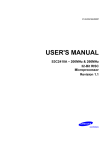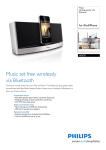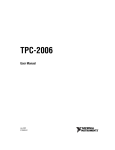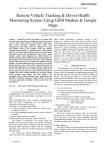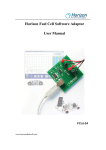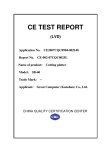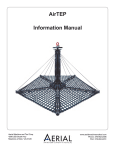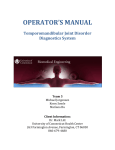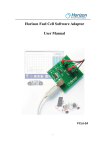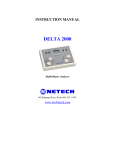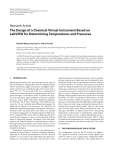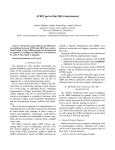Download The Study of Portable Remote Multi-life-parameter
Transcript
2011 IEEE 13th International Conference on e-Health Networking, Applications and Services The Study of Portable Remote Multi-life-parameter Monitoring Network Qinwu Zhou, Ziwei Lin, Junhong Chen , Hongyan Fu School of Life Science and Technology Xi’an Jiaotong University, XJTU Xi’an, P.R.China, 710049 Mindray Company developed the PM-8000 Portable Multi-life-parameter monitor, which monitors the user's ECG, blood pressure and oxygen parameters. December 2007, China Laikang Company successfully developed the world's first PHA (Personal Health Assistant) ECG remote monitor. However, monitors mentioned above are either single parameter or lack of some functions such as GPS. Due to the simultaneous requirements of high-performance and low cost, full-featured products are not seen in widely use or even still in research or trial. This paper presents a portable physiological parameter monitoring system. The system is suitable for the general consumption level and network construction situation in most areas of China. The whole medical monitoring network is illustrated in Fig.1. It supports several kinds of communication application models [5,6] as listed in Tab.1. The terminal collects the user's ECG, body temperature, blood pressure and other key life parameters, with self-diagnosis and alarm functions. If abnormal parameters are detected, anomaly data, alarm signal and GPS data will be transmitted to the monitoring center automatically and immediately. The terminal can be connected to PC via USB, transferring data by cable networks. Moreover, the system is mainly designed for wireless use in open air, using GPRS (General Packet Radio Service, GPRS) method as the primary means of data communication. Abstract— With the development of modern signal processing and computer network technology, it brings new challenges to remote health care structure. This paper discusses a prototype which realizes the functions of physiological signal collection and calculation, GPS global positioning, and data transmission through GPRS. The new type of portable multi-life-parameter physiologic monitoring terminal is based on embedded design method. It consists of physiological signal collection unit, GPS unit, data storage unit, data analysis unit, LCD (320*240) display unit and data communication unit. The physiological signal collection unit includes ECG, temperature, blood pressure and blood sugar part. The server system deals with physiological database, user information, interacting of physician-patient with audio and video, computer automatic diagnosis, wired or GPRS data transmission. We expect to solve the shortcoming of poor operability, large volume and high price of the traditional biological monitoring devices. Multi-life-parameter of the patients can be monitored remotely and wirelessly, with the advantages of good operability, strong scalability, small size, low cost, high reliability and real-time processing. Keywords—Telemedicine, physiological parameters, GPS, GPRS, monitoring terminal I. INTRODUCTION B ecause of the time and cost, patients usually will not keep staying in hospital until full recovery. Instead, they typically choose to leave hospital first and take periodical subsequent visits. Therefore it becomes hard to track chronic disease and rehabilitation after surgery. In recent years, related technologies have developed rapidly, making portable multi-life-parameter monitor a desirable research topic[1]. Wirelessly powered patch-type healthcare sensor IC [2] made by P-FCB (planar-fashionable circuit board) technology and micro-machined ECG electrode [3,4] based on MEMS (Micro-Electro-Mechanical Systems) technology have been developed successfully. March 2004, the United States CardiNet company successfully developed ECG remote monitoring technology based on CDMA digital mobile phones. May 2004, an ECG remote monitoring system with GPS was developed in some regions of Spain. June 10th, 2005, the heart remote monitoring center in Qilu Hospital of Shandong University established Asia's first GPRS wireless communication network remote monitoring institutions (cardiac remote monitoring system). May 2006, China II. TERMINAL STRUCTURE The portable multi-life-parameter monitoring terminal adopts ARM9 processor S3C2410A, rich in on-chip resources, such as 8 channels AD converter, 3 channels UART, USB controller and SD card controller. It consists of five parts [7], the physiological data collection, management, data processing and display, communication, and the GPS positioning part. The terminal takes ECG and body temperature as basic monitoring parameters. ECG is acquired by high-quality and cost-effective Ag/AgCl electrode. I-lead, II-lead, V-lead ECG filter and collection circuit are designed using standard five-lead cable and formed by Wilson resistor network. For monitoring use, 5-lead is enough. Too many leads will increase the number of ECG data, system cost and communication expense. The parameters of the ECG collection circuit are listed in Tab.2.The body temperature is detected by ET series NTC resistor with measuring range of 130 TABLE I SEVER COMMUNICATION MODEL Communication method Application environment Wireless outdoors Cable at home, in community or departments of the hospital. regional interconnection between hospitals TABLE II ECG COLLECTION CIRCUIT PERFORMANCE Methods Item after physiological signals are acquired by the terminal, the terminal is connected to the server in hospital and data are transmitted through GPRS network. physiological signals are acquired at home or in community clinics,the terminals are connected to the server in hospitals through cables which connect PCs into internet. Data communicate among hospitals in different regions through Internet measure range CMRR sample rate band-pass frequency trap frequency input impedance AD resolution Performance +/-2.5mV >80dB 300Hz 0.05~100Hz 50Hz >100MΩ 10 bit ire w 18~45˚C and accuracy of ±0.1 ˚C. Blood pressure, blood sugar and other parameters can be measured via external monitor modules which are optional and connected to the terminal through UART port. The terminal is tested successfully on Omron Upper Arm Blood Pressure Monitor HEM-752(deviation±4mmHg), OneTouch Glucometer (measure range 0~ 33.3mmol/L and deviation 0.1mmol/L), and the fetal heart sound monitor (applied to Doppler ultrasound and DSP technology, measure range 60~240 bpm) developed by our lab. After filtered, amplified and AD converted [8], the signals are stored in the mass storage device (on-board flash or SD,TF card) to be uploaded. The calculated results such as heart rate and body temperature are stored in database to be analyzed. In addition, the authority of data operation makes sure the data safety and privacy. In data processing part, the terminal analyzes the data by parameters such as P-R interval and body temperature. The instantaneous and average heart rate, P-R and Q-T interval are calculated by ways of threshold and slope to detect QRS complex[9,10]. Meanwhile, the terminal reads the blood pressure, blood sugar and etc. through UART. Comparing the parameters with those in normal range, it estimates whether the user is healthy or not. The results are displayed on the TFT LCD screen to users. Considering the system’s load capacity, the terminal supports static and dynamic display solutions. The static one lets the user observe specified period physiological data, and the dynamic one always displays the latest sampling data and result. Once the terminal detects abnormal physiological parameters, it will give an alarm. The user’s present latitude and longitude coordinates will be sent to the server right away and displayed on the terminal in the way positioning software OziExplore uses. The location information is read from GPS module [11] through UART. Then the longitude and latitude are recognized by GPRMC or GPGGA sentences. After picking three points (not overlapped) on the map as basic Fig 1 The medical monitoring network points, any location on the map will be confirmed by calculating the latitude and longitude of them. The test of the GPS part shows the deviation of the GPS system is less than 50 meters (limited by the precision of the map). Thus, the transmitted GPS information will save a lot of valuable time for the rescue. The maps on the monitor are configurable which can be updated by users according to his living area. Telemedicine communication includes wired telephone network, cable internet network, WLAN, satellite communications, RF communications, infrared communications, mobile network (GSM, CDMA) and etc [12].Considering cost and portability, the data are transmitted by two ways. In the first way, the terminal is connected to PC on which physiological data are displayed. Then to the server by the cable which connects PC to the Internet. In the second way, the data are transmitted through GPRS into the Internet by operating GPRS module [13] through UART using AT commands. CRC checksum is used to ensure the data exactness. The data from terminal to server includes user ID, data type, collection time, data size, data and CRC code. In order to improve the real-time performance and stability, RTOS μC/OS-II is ported on the terminal. The RTOS is in charge of task management. The task priorities are differentiated according to interrupt relevance, urgency and requirements. Task priority descends from data receiving, acquisition, sending, device input, data processing to display task. File system μC/FS is also ported to manage mass storage device with FAT file supported. III. THE SERVER SYSTEM ARCHITECTURE The operating system of central server is Windows XP. The server software’s system architecture is divided into 3 layers. The data layer has two parts. One is database which takes charge of the storage and management of the patient's medical records, physiological data, user accounts as well as linkage records between patients and server, the other is data stream 131 which is to provide point-to-point instant messaging and audio and video communication. The control layer mainly contains sending and receiving control which supports connection via GPRS and cable networks, data control which operates database directly, including data storage, inquiry, modification, automatic diagnosis and account management, and then display control which is responsible for reacting and feeds back commands. The interface layer is an interactive platform between software system and users to clearly and accurately describes the ECG I,II,V waveform, physiological data, patient’s basic information, audio and video communication, and instant messages with patients connected. The database structure design of the server utilizes VC++ , MS SQL Server developing environment, MS ODBC specification and standard database APIs. The procedure operates database which maintains 5 entries to search, add, edit, delete and so on. With Microsoft COM module RTC APIs, software system can create PC-to-PC,PC-to-terminal calls, instant messaging, application and “draws” board sharing through Internet. RTC supports many kinds of decoders based on the communication ability and bandwidth, including G711, G722.1, G723, GSM, DVI4 and SIREN. Video decoder contains H.263 and H.261 [14]. In this paper, H.263 is selected with bit rate of 6Hbps~125Kbps and OCIF and CIF media forms supported. The video capture mode is MSH263. This paper utilizes multi-thread technology to meet the needs of handle multiple connection simultaneously from clients. The main thread is responsible for monitoring. It monitors if the users’ data are transmitted then creates a new communication thread which carry out data transfer reliably with users by data communication channels. In order to transmit data between the server and the client, we have designed a set of suitable communication protocols. The communication protocols can be divided into following parts: 1) Handshake signal: It’s used for the client request connection to the server with user’s ID packaged in it. 2) The server receives handshake signal and analyzes the data packet. If the ID is confirmed, the server establishes an interface channel with the user. 3) The client receives server’s confirmation, then it starts to send physiological data packet. The large amount of ECG data can be divided into many data packets and transmitted in turn. Different types of data packets can be distinguished in different identities with packet order, transmission time and other information packed in it. The server receives data packet, analyzes its content, and carries on CRC verification. Then, the client is noticed whether to continue with the next packet or to re-send the current data again based on the verification result. 4) After finishing the data transmission, the client sends conclusion signal to the server. The server confirms type of physiological data and feeds back computer automatic diagnosis results, or notices the client to stop communication directly. IV. RESULT AND DISCUSSION The experimental environment of the whole system is shown in Fig.2. In order to check whether the terminal works well and server network design is correct, patient simulator (MiniSim 1000 V1.3r2 designed by Neteck Corp.) is connected with 5-lead cable to the terminal. Also, external module like blood pressure module, blood sugar and fetal heart sound monitor are connected. The test result is shown in Fig.3. The calculation of heart rate is correct and the deviation is less than 2 bpm. Because the power of terminal is supplied by AC adaptor, the result also shows the influence of the power frequency. Fig.4 shows the display on PC, and the ECG waves are I, II, V lead in turn. Digital FIR filter is designed for the PC program, so the baseline drift problem and power frequency interference problem are well solved, and the QRS complex, T-wave, P-wave are legible. Fig.5 shows the display on the server. The physiological signal parameters are shown on the left, the display settings on the right, and ECG waves in the central. V. CONCLUSION This paper proposes and realizes a telemedicine prototype which consists of different tele-medical modes, interaction of many kinds of signals, variety of transmission methods, data storage, and information management. It provides centralized management of data, information interaction, diagnostic alarm and many other functionalities for clients. It also realizes measurements of ECG, blood pressure, blood glucose and other physiological parameters, as well as real-time location of users. The prototype is flexible and has great extendibility. To continue with the project, we will make more efforts to strengthen data security of tele-medical system. For example, data encryption or distributed system which separates data and control may be used. We will also explore compatible problems between data information and existing medical standard. With the developing medical technology and rapidly-sharing information in the future, it’s an important area how to make telemedicine system adapt to the needs of different tele-medical modes and to provide more convenient, more economical, and more comprehensive services to doctors and patients. The prototype introduced in this paper is an innovation and attempt in this area. REFERENCES [1] [2] [3] 132 B. A. Walker, et al., "Low cost ECG monitor for developing countries," in Intelligent Sensors, Sensor Networks and Information Processing (ISSNIP), 2009 5th International Conference on, 2009, pp. 195-199. L. Yan, et al., "A 0.5-mu V-rms 12-mu W Wirelessly Powered Patch-Type Healthcare Sensor for Wearable Body Sensor Network," Ieee Journal of Solid-State Circuits, vol. 45, pp. 2356-2365, Nov 2010. L. M. Yu, et al., "A MEMS-based bioelectrode for ECG measurement," in Sensors, 2008 IEEE, 2008, pp. 1068-1071. Fig.3 Test result of terminal Fig 2 The experimental environment of the system Fig.4 Display on PC [4] [5] [6] [7] [8] Fig.5 Display on the server D. G. Guo, et al., "A wearable BSN-based ECG-recording system using micromachined electrode for continuous arrhythmia monitoring," in Medical Devices and Biosensors, 2008. ISSS-MDBS 2008. 5th International Summer School and Symposium on, 2008, pp. 41-44. Yoo, S. K., K. M. Kim, et al. (2004). Design of Multimedia Telemedicine System for Inter-hospital Consultation. Engineering in Medicine and Biology Society, 2004. IEMBS '04. 26th Annual International Conference of the IEEE. Jing, B., H. Bingyi, et al. (1997). "A communication server for telemedicine applications." Information Technology in Biomedicine, IEEE Transactions on 1(3): 205-209. L. Jin, et al., "A Multimedia Telemedicine System," in Biomedical Engineering and Computer Science (ICBECS), 2010 International Conference on, 2010, pp. 1-3. Analog Devices, Inc. AD620 Instrumentation Amplifier E manual [M]: Analog Devices, Inc, 1999 1-14. [9] [10] [11] [12] [13] [14] 133 JIAPU PAN and WILLIS J.TOMPKINS, A Real-Time QRS Detection Algorithm, IEEE Transactions On Biomedical Engineering, VOL. BME-32, NO. 3, MARCH 1985 Jianxin Qi, Zhengzhong Bian, QiangYang. PC-based real-time automatic ECG analysis system [J]. Beijing Biomedical Engineering, 1997, (3) :133-136. SiRF.SiRF star III User Manual [M]: SiRF Technology Inc, 2005 1-3. D. Ziadlou, et al., "Telecommunication Methods for Implementation of Telemedicine Systems in Crisis," in Broadband Communications, Information Technology & Biomedical Applications, 2008 Third International Conference on, 2008, pp. 268-273. SIEMENS. MC55/56 Hardware Interface Description Version 2.06 manual [M]: SIEMENS, 2004 73-78. Youlong Luo, Yuanyi Tang. The RTC client API programming [J]. Journal of Xi’an Institute of Posts and Telecommunications, 2003,8 (1) :37-40.




